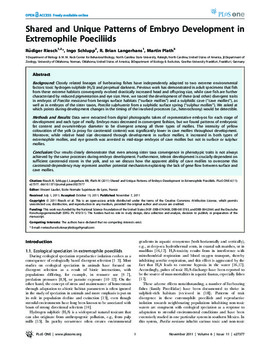| dc.contributor.author | Rüdiger Riesch | en_US |
| dc.contributor.author | Ingo Schlupp | en_US |
| dc.contributor.author | R. Brian Langerhans | en_US |
| dc.contributor.author | Martin Plath | en_US |
| dc.date.accessioned | 2015-01-23T17:17:33Z | |
| dc.date.accessioned | 2016-03-30T15:35:35Z | |
| dc.date.available | 2015-01-23T17:17:33Z | |
| dc.date.available | 2016-03-30T15:35:35Z | |
| dc.date.issued | 2011-11-07 | en_US |
| dc.identifier.citation | Riesch R, Schlupp I, Langerhans RB, Plath M (2011) Shared and Unique Patterns of Embryo Development in Extremophile Poeciliids. PLoS ONE 6(11): e27377. doi:10.1371/journal.pone.0027377 | en_US |
| dc.identifier.uri | https://hdl.handle.net/11244/14071 | |
| dc.description | We would like to thank L. Arias-Rodriguez, T. J. Colston, F. J. García de León, and M. Tobler for help during the collections in the field. The Mexican Government and the Municipal of Tacotalpa kindly provided permits for the work in Mexico. | en_US |
| dc.description | Conceived and designed the experiments: RR. Performed the experiments: RR. Analyzed the data: RR. Contributed reagents/materials/analysis tools: RR IS RBL MP. Wrote the paper: RR IS RBL MP. | en_US |
| dc.description.abstract | Background Closely related lineages of livebearing fishes have independently adapted to two extreme environmental factors: toxic hydrogen sulphide (H2S) and perpetual darkness. Previous work has demonstrated in adult specimens that fish from these extreme habitats convergently evolved drastically increased head and offspring size, while cave fish are further characterized by reduced pigmentation and eye size. Here, we traced the development of these (and other) divergent traits in embryos of Poecilia mexicana from benign surface habitats (“surface mollies”) and a sulphidic cave (“cave mollies”), as well as in embryos of the sister taxon, Poecilia sulphuraria from a sulphidic surface spring (“sulphur mollies”). We asked at which points during development changes in the timing of the involved processes (i.e., heterochrony) would be detectible. Methods and Results Data were extracted from digital photographs taken of representative embryos for each stage of development and each type of molly. Embryo mass decreased in convergent fashion, but we found patterns of embryonic fat content and ovum/embryo diameter to be divergent among all three types of mollies. The intensity of yellow colouration of the yolk (a proxy for carotenoid content) was significantly lower in cave mollies throughout development. Moreover, while relative head size decreased through development in surface mollies, it increased in both types of extremophile mollies, and eye growth was arrested in mid-stage embryos of cave mollies but not in surface or sulphur mollies. Conclusion Our results clearly demonstrate that even among sister taxa convergence in phenotypic traits is not always achieved by the same processes during embryo development. Furthermore, teleost development is crucially dependent on sufficient carotenoid stores in the yolk, and so we discuss how the apparent ability of cave mollies to overcome this carotenoid-dependency may represent another potential mechanism explaining the lack of gene flow between surface and cave mollies. | en_US |
| dc.language.iso | en_US | en_US |
| dc.publisher | PLos One | en_US |
| dc.relation.ispartofseries | PLoS ONE 6(11):e27377 | en_US |
| dc.relation.uri | http://www.plosone.org/article/info%3Adoi%2F10.1371%2Fjournal.pone.0027377 | en_US |
| dc.rights | Attribution 3.0 United States | en_US |
| dc.rights.uri | https://creativecommons.org/licenses/by/3.0/us/ | en_US |
| dc.subject | PLOS | en_US |
| dc.subject | Public Library of Science | en_US |
| dc.subject | Open Access | en_US |
| dc.subject | Open-Access | en_US |
| dc.subject | Science | en_US |
| dc.subject | Medicine | en_US |
| dc.subject | Biology | en_US |
| dc.subject | Research | en_US |
| dc.subject | Peer-review | en_US |
| dc.subject | Inclusive | en_US |
| dc.subject | Interdisciplinary | en_US |
| dc.subject | Ante-disciplinary | en_US |
| dc.subject | Physics | en_US |
| dc.subject | Chemistry | en_US |
| dc.subject | Engineering | en_US |
| dc.title | Shared and Unique Patterns of Embryo Development in Extremophile Poeciliids | en_US |
| dc.type | Research Article | en_US |
| dc.description.peerreview | Yes | en_US |
| dc.description.peerreviewnotes | http://www.plosone.org/static/editorial#peer | en_US |
| dc.identifier.doi | 10.1371/journal.pone.0027377 | en_US |
| dc.rights.requestable | false | en_US |

